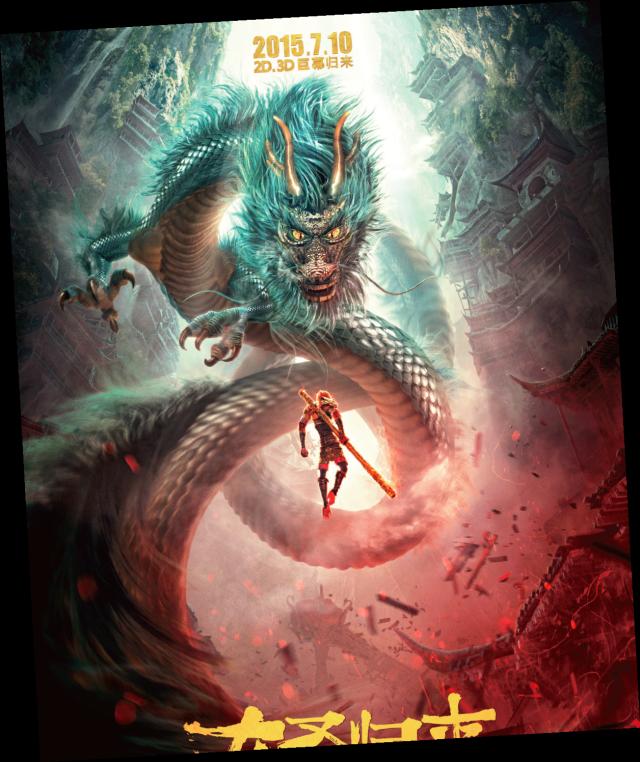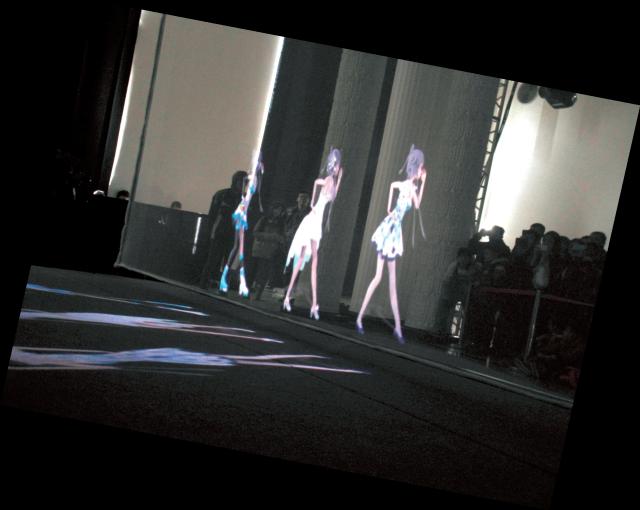On February 2, when a lavish live broadcast screened in the run up to the Chinese New Year Gala produced by Hunan TV was in full swing, singer Yang Yuying was already waiting anxiously backstage. Minutes later, she was to appear in front of a potential audience of millions, performing alongside a gray-haired, green-eyed, sweetly voiced girl named Luo Tianyi. At the tender age of 15, Luo has already released 6,000 original songs, with 100 new songs added to her repertoire each month. Luo’s extraordinary productivity might appear impossible, until one realizes she is actually a computer-generated song generator produced by VOCALOID, a singing synthesizer application formerly developed by Yamaha Corporation.
Virtual reality (VR) technology enables this virtual “2-D” diva to appear in concert in what critics dubbed a “pan-dimensional” performance, blurring the wall between the “2-D” or “virtual” and “3-D” or “real” world.
The phenomenon of so-called pan-dimensional entertainment is now well-established in China, with Luo Tianyi just one example of its success. With China’s younger generation emerging as the nation’s leading consumers, the domestic ACGN (anime, comics, gaming and graphic novel) industry has experienced an unprecedented boom since 2015. The term “2-D” has gradually become a buzzword that has crossed from the online realm into the mainstream media, and its associated values have attracted the attention of China’s IT giants.
The 2-D market, previously dismissed as kooky and niche, is now viewed as a new commercial frontier. Manufacturers and distributors are fighting for a slice of the lucrative 2-D economy.
Capital has played the most significant part in breaking down the walls between the two cultural dimensions, but what has fascinated observers has been the ability of 2-D consumers, simultaneously ravenous and exacting in their demands, to determine which content creators make the grade. When the two worlds of old-school commercialism and youthful individualism collide, it seems that reconciling them requires considerable expertise.
Market In contrast with Japan’s long-established ACGN industry, which still relies heavily on traditional print publishing, the growth of China’s ACGN industrial chain has always been rooted in the IT industry.
The popularization of 2-D culture in China coincided with the development and widespread adoption of mobile Internet (MI) platforms in the last five to 10 years.
Since 2005, with the rise of Web 2.0 (instant messaging, social networking and video sharing), content creators have been offered myriad convenient platforms to promote 2-D culture on a massive scale. Since 2010, the gradual emergence of MI devices, especially smartphones, as a dominant tool for social interaction has allowed end users to devote every second of their spare time to consuming online ACGN materials.
Thanks to MI technology, consuming online 2-D materials has become an organic and inseparable part of teenage and young adult life.
According to data compiled by tech consultancy iResearch, in 2015, the total number of Chinese 2-D consumers reached about 219 million, of whom 59 million were listed as core users. While many are still college or high school students and have limited purchasing power, as this generation ages their tastes have been shown to remain fairly consistent, meaning that future potential of this nascent market could be huge.
2015 was a milestone year for China’s 2-D generation, as this former geek legion emerged from the shadows to make cultural inroads in the 3-D mainstream.
2-D slang and inside jokes, many lifted from Japanese and English, have gained widespread traction in everyday parlance and have been widely accepted and spread in the 3-D world. “Moe moe,” (very cute), “adorkable,” “tsukkomi” (trash talk) and “ranbingluan” (no damn use) commonly crop up in online discussions and everyday conversation.
On July 3, 2015, during the Huxiu Summer F&M Innovation Festival, Bilibili CEO Chen Rui commented: “From my perspective, the subculture of the [generation born in the ’90s and ’00s] will in fact determine the direction of mainstream Internet culture in the next 10 years.” State broadcaster CCTV’s reportage on the 2-D community symbolizes this former fringe group’s emergence as a leading cultural force.
On January 8, CCTV Morning News aired a 14-minute special on the 2-D phenomenon, touching on its culture, the scale of related industries, associated startups and investments, and the group’s market potential.
In 2015, capital began to flood into the 2-D market as tech giants realized the potential of China’s ACGN industry.
Video-sharing websites acfun.tv and bilibili.com, leading outposts of China’s 2-D content creators as well as those illegally uploading copyrighted content, were respectively acquired by Internet giants Alibaba and Tencent. Nicknamed “A Station” and “B Station” by 2-D users, these two so-called “bullet-screen” websites, which allow users to see their submitted comments and scroll through remarks on screen in real time while watching video clips, are hugely popular with netizens. They also serve as platforms through which distributors and content producers can trawl for talent.
“Watching the scrolling bullet screen is similar to watching a soccer match in a stadium. When the favored team scores, everyone stands up and cheers, ” AcFun CEO Mo Ran said of A Station. “The scrolling chat creates a similar effect, giving viewers the sense that they are watching a video clip together. They laugh at the same points, and interact with each other. A Station gives 2-D youths – most of whom grew up without siblings – a boisterous platform with a carnival-like atmosphere.” In August 2015, AcFun received a US$50 million investment from China’s YouTube equivalent, Youku Tudou. After Alibaba acquired Youku Tudou last November, AcFun was absorbed by the Alibaba brand. Later AcFun secured a further US$60 million from SoftBank China Venture Capital.
Also last November, Tencent Holdings invested around US$30 million in Bilibili after the company was valued at US$228 million.
Rival animation site u17.com, meanwhile, was snapped up by the Guangzhou-based animation studio Alpha, currently China’s leading producer of domestic animation.
Some are already calling the second decade of the 21st century China’s 2-D Golden Age.
Sticky During the Tencent Animation Industry Conference held on November 19, 2015, company vice president Cheng Wu coined the term “2-D Economy” while outlining Tencent’s strategy for cornering this market by producing and managing high-quality intellectual property (IP), and exploiting it through production of animation, comics, movies, TV shows, games and literature.
The IP-oriented 2-D economy is aiming to cash in on what insiders call the “stickiness” of consumers. 2-D youths, deeply emotionally attached to the objects of their passion, reliably consume tie-ins and spin-offs as well as premium original content, leading some to describe the 2-D economy as an “economy of fandom.” These tech-savvy, emotionally invested, brand loyal and, in many cases, highly productive young consumers can simultaneously serve as end users, advertisers and content creators, making them ideal targets for companies invested in 2-D products. Song generator Luo Tianyi, for example, is a creation of her fans, with details such as her facial features, outfits and even “public appearances” designed “by the market,” in the words of Cheng Ruohan, vice general manager of Shanghai HENIAN, Luo’s parent company.
While Shanghai HENIAN might have come up with the concept of a holographic preteen diva, the fine tuning, from her shoes to her hairstyle, is decided by netizens. “Having no official character setting is our principle,” said Cheng. Luo’s physical appearance is a composite that includes elements from some 1,500 illustrations submitted to the company through online platforms, many drawn by professional illustrators. Her voice, meanwhile, is based on that of 2-D idol and voice actress Shan Xin.
Community Doujin is a Japanese term for a group of people who share an interest.
In ACGN culture, the term specifically refers to amateur selfpublished works, including manga, novels, illustrations or songs based on an original ACGN work. The day after Luo Tianyi’s debut in July 2012, the doujin songs created by fans began being published on online platforms, including AcFun and Bilibili. To compose an official doujin tribute song to Luo, fans were required to spend nearly 2,000 yuan (US$308) to buy VOCALOID™3 and its related software.
A number of Luo’s doujin songs went viral online. Luo herself has 400,000 followers on Twitter-equivalent Sina Weibo, and Shanghai HENIAN claims her songs have racked up over 200 million hits on various online platforms.
“We will integrate fans’ creativity into the construction and promotion of our brand,” said Cheng Ruohan. “Fans’ efforts have helped build the public’s overall image of Luo Tianyi.” Virtual pop divas aren’t the only icons giving a public face to the 2-D new wave. A creative take on one of China’s best-loved literary figures has also become a symbol of the movement.
In 2015, the indigenous animated feature Monkey King: Hero is Back defied expectations to become a runaway hit, earning plaudits from tens of thousands of fervent fans who took to social media to promote it. Despite the relative obscurity of the movie, which was initially released with little fanfare, word of mouth soon led to the movie’s Weibo fan club being flooded by 40,000 new members. These superfans described themselves as “tap water” – emphasizing the free and flowing nature of their promotion. The term contrasted with “water
army,” a pejorative used to describe people paid either by political or commercial interests to disingenuously promote certain works or products.
In short, fans of Monkey King: Hero Is Back did the studio’s work for it, even going so far as to purchase tickets as gifts for strangers simply to encourage more people to see the movie. Soon, the film had broken the box office record set by DreamWorks’ Kung Fu Panda 2 to become the most successful animated film of all time in the Chinese mainland market.
“This is a film of our own. We’ve done so much. We drew fan art, wrote fan fiction, posted and reposted numerous tweets, and recommended the film to our friends, people near us, and also other netizens,” self-styled “tap water” fan artist Nana (pseudonym) told our reporter. “We’ve all made our own contributions and we are so happy and proud of its success.” Profits That kind of passion and brand loyalty has made China’s 2-D consumers the prime targets of most enterprises in the cultural industries, with a once-fringe cornucopia of diverse products quickly becoming the leading light of mainstream pop culture.
However, the consistent use of terms such as “capital,” “eco-chain,” “ACGN eco-circle,” “Internet Plus,” and “pan-entertainment” by companies attempting to tap the 2-D market adds a gloss of hardnosed utilitarianism seemingly at odds with the fiercely individualistic and idealistic worldview espoused by their target market.
Younger entrants to the market feel that many businesses hoping to profit from 2-D consumers have no understanding of the people they are trying to reach. “Many investors were born in the 1950s and 1960s, with no concept of 2-D,” said Wang Quan, the 27-year-old vice president of newly minted angel investment firm Autobot Capital Partners. “Out of fear that they might miss out on a great opportunity because of their ignorance, they still invest in one or two 2-D companies.” Many argue that by interfering too much in ACGN content, and over-commercializing cultural products, mainstream content creators too driven by profits might find their returns less satisfactory than they expect.
2-D youths may be insatiable consumers, but their appetites are limited only to the products that resonate with them.
Far from being easily pleased, a casual glance at online message boards or the scrolling text accompanying videos on AcFun or Bilibili prove how discerning 2-D young people are when it comes to the world in which they have immersed themselves. If cynical profit-seeking is detected behind a cultural product, it will often be rejected.
One significant reason behind the success of Monkey King: Hero is Back is that the indie nature of the film and its reputation as a labor of love epitomized the creative spirit of the 2-D generation. The movie’s 41-year-old director, Tian Xiaopeng, optimistically committed himself to completing his low-budget work, and his well-documented love for comics and sci-fi, particularly the Transformers franchise (he scrapbooked dozens of posters featuring the series’ characters “as if they were precious stamps”), has seen him evolve into something of an anti-establishment 2-D hero in the mold of Joss Whedon in the West.
Tian’s primary goal was not to do well at the box office – still the go-to measure of a movie’s success in the mainstream media – but to realize a personal vision. Tian described the production process as “a gamble of idealism”: he spent eight years on the project and had to overcome a litany of obstacles before it was completed. “I always wished that I could have an exciting and heroic life in which I could make a difference. Considering my personal background... Perhaps [producing Monkey King: Hero is Back] is most approximate to [having] the lifestyle that I want,” Tian remarked in an interview with NewsChina.
While on the face of it, China’s 2-D generation might seem the perfect consumer base, in practice, their sophistication and commitment to authenticity currently jars with major companies’ often mercenary approach to business. Until mutual understanding is established, this legion of geeks will continue to resist attempts to manage or restrict their passion for the creative and the kooky.

 Old Version
Old Version

